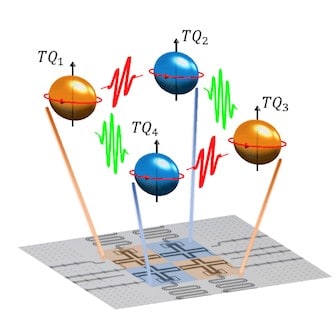Geometric tensor measured in a superconducting quantum circuit

Researchers at Nanjing University in China have used a superconducting quantum chip to simulate a system of particles that are neither fermions nor bosons. As part of this simulation, they measured a parameter known as the quantum geometric tensor that provides local information about the system’s topological properties.
The work marks the first time this quantity has been measured in a so-called non-Abelian system – a result that will be useful for studying the physics of complex systems such as topological materials.
According to quantum mechanics and quantum field theory, all elementary particles fall into one of two groups: fermions or bosons. Fermions such as electrons obey the Pauli exclusion principle, meaning that no two fermions can ever occupy the same quantum state.
This propensity to flee from each other is at the heart of a wide range of phenomena, including the electronic structure of atoms, the stability of neutron stars and the difference between metals (which conduct electric current) and insulators (which do not).
Bosons such as photons, on the other hand, tend to group together – something that gives rise to superfluid and superconducting behaviours when many bosons exist in the same quantum state.
Advertisement
Neither one thing nor the other
Some materials, however, contain other, more exotic types of elementary particles. These non-Abelian particles are neither bosons nor fermions. Instead, they are made up of composite particles such as strongly-interacting electrons, which gives rise to many unique characteristics.
One is degeneracy, meaning that non-Abelian particles in multiple quantum states may sit at the same energy. In particular, many quantum states can occupy the lowest energy level, forming a degenerate ground state. Such states are robust to perturbations in their environment since the degenerate ground states are separated by an energy gap from the excited, higher-energy, states.
Another key property of non-Abelian particles is that interchanging two of them shifts the system between different ground states. “If a series of interchanges is carried out in a certain order, the final state of the system will depend on this order, indicating that this manipulation is independent of details such as the interaction between particles or the environment,” explains Yang Yu, who led the study.
“These all make such systems ideal candidates for so-called topological quantum computation. The problem, however, is that it is difficult to realize and characterize a non-Abelian system in a real-world experiment.”
In non-Abelian systems, the quantum geometric tensor has a more complex mathematical structure than it does in systems of bosons and fermions, and it correspondingly embodies more physics phenomena.
While researchers have measured the quantum geometric tensor of Abelian systems (including superconducting quantum circuits and nitrogen-vacancy-centre platforms) in recent years, they had not previously done so for non-Abelian ones.
Advertisement
Four tuneable superconducting qubits
In the new work, Yu and colleagues studied a system made up of four tuneable superconducting quantum bits (qubits) assembled in a ring structure and coupled to each other. “By modulating the qubit frequency quickly and periodically, we can freely design the magnitude and phase of the coupling strength between the nearest-neighbour qubits, and hence a non-Abelian system whose geometrical properties we can explore,” Yu explains. “And by properly modulating its parameters, we can extract the entire quantum geometric tensor from the oscillation patterns between quantum states of the system,” he tells Physics World.
The researchers say that the present work shows that a superconducting quantum chip is an excellent platform for quantum simulation. They now hope to simulate more complex quantum systems and explore new physics with more qubits.
Advertisement